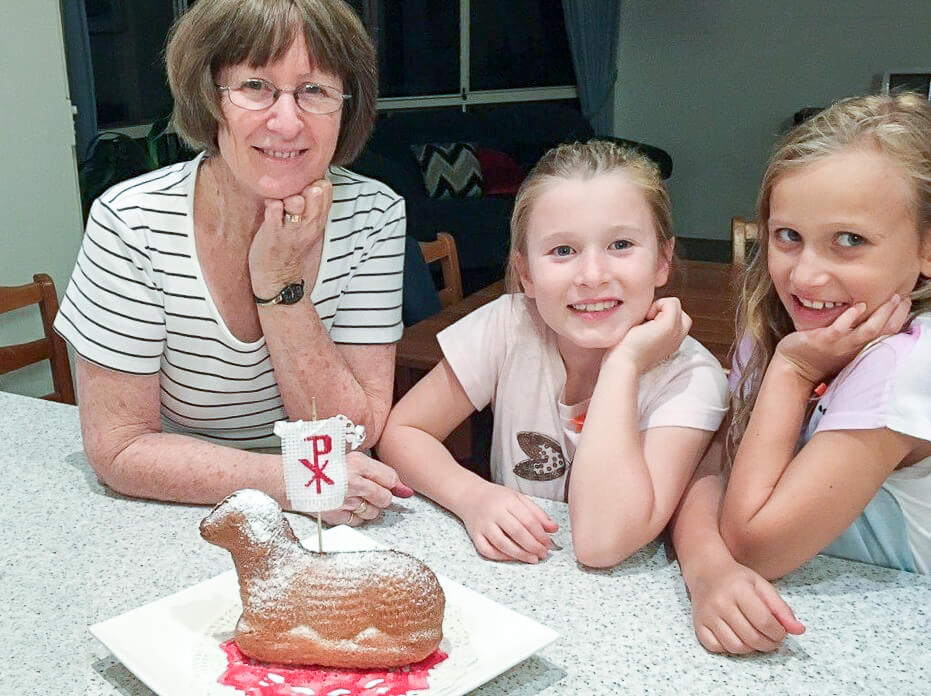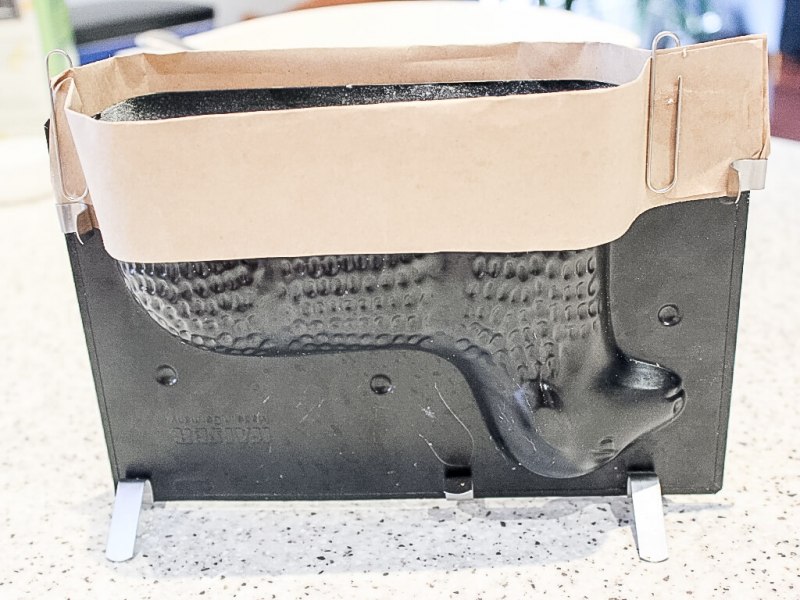The Easter lamb cake (in German Osterlammkuchen) is one of southern Germany’s enduring Easter symbols.
Baking or purchasing a lamb cake and serving it on Easter Sunday is a tradition many southern German families have passed down from generation to generation.

Up until several years ago, I had never heard of a lamb cake. It was not something my Australian family (or any other Australian family I knew) baked or purchased at Eastertime.
In March-April 2012, my husband and I spent the weeks leading up to Easter, and the Easter weekend, with our extended family in Bavaria, southern Germany. I have written about our experience previously in Easter in Germany: Bavaria (March 18, 2016). It was during this visit that our family there introduced us to the Easter lamb cake – a small, rich madeira cake in the shape of a lamb.
Although most families wait until Easter Sunday to serve the lamb cake, our host broke with tradition and served ours during Holy Week (the week leading up to Easter). What a beautiful, quirky little lamb it was! But we all laughed as the cake was cut, because our family’s lamb had a little accident in transit, a bump on its nose!

I loved the lamb cake. It was delicious. But more importantly, I was rapt that the German people used the lamb as a symbol of Easter. It’s so appropriate. After all, Easter is a Christian festival that commemorates the death, burial and resurrection of Jesus Christ, the “Lamb of God” (John 1:29).
I was so impressed by the Easter lamb cake that I wanted to make it myself at Eastertime.
Of course, I needed a lamb mold (“Lammform”). Fortunately, when we visited Regensburg on Easter Saturday, I spied one in a shop window. It didn’t matter how much it cost, I was going to buy it. And I’m so glad I did.
Since 2012 when I purchased my Kaiser non-stick lamb mold, I’ve baked the lamb cake whenever I’ve been home at Eastertime. The recipe I use came with the lamb mold I purchased in Germany, so it’s authentically German. You’ll find the recipe at the end of this post.
My granddaughters helped me make our family’s first Easter lamb cake in 2016. Actually, we made two lamb cakes that Easter because, I must confess, the first cake we made was a flop! During baking, some of the mixture overflowed the mold and, as a result, our poor lamb wouldn’t stay upright! So, for our second attempt, I added a paper “collar” to the lamb mold, which solved the problem. We were all very pleased with the end result.

Yesterday, I baked and decorated my lamb cake for Easter this year.
You may be wondering why I added the banner to my Easter lamb cake. It’s an important part of the cake’s symbolism. This miniature embroidered banner came with the German lamb mold I purchased. It displays the Chi-Rho, a symbol comprising two overlapping capital Greek letters, Chi (X) and Rho (P), the first two letters of the word “Christ” in Greek (ΧΡΙΣΤΟΣ, Christos).
If you would like to purchase a German lamb mold, I’ve seen some advertised on Amazon.co.uk. Check out this link.
EASTER LAMB CAKE
Ingredients
100 g soft butter
100 g (½ cup) sugar
2 teaspoons vanilla sugar (or 1 teaspoon vanilla extract + sugar)
pinch salt
2 eggs
1 tablespoon rum
60 g (½ cup) ground almonds
60 g (½ cup) plain flour
60 g (½ cup) corn flour (or arrowroot)
1 teaspoon baking powder
For dusting: sifted icing sugar
Method
- Prepare the lamb mold by greasing the two parts liberally with butter and dusting with flour.
- Clip the two parts of the mold together. Add a border of thick paper at the opening (to prevent cake mixture overflowing). Set mold aside.
- Beat the butter until light and creamy.
- Add sugar, vanilla sugar and salt. Beat until the mixture comes together.
- Add egg and rum and beat until evenly mixed.
- Finally, add the dry ingredients. Combine by hand mixing or by electric mixer on low speed.
- Fill the upside-down mold with the prepared cake mixture.
- Place the upside-down mold on a tray at the lowest level of the oven.
- Bake at 180 degrees Celcius (or 160 degrees Celcius if fan-forced) for about 40 minutes.
- When cooked, allow the cake to stand for at least 15 minutes before carefully removing the mold.
- When cool, dust the cake with sifted icing sugar and decorate as desired.



















Hi Judy, I have enjoyed reading your information and recipe and may buy the tin for next Easter. I passed it on to my family who are accomplished cooks. I’m sure I asked you previously if I could share with our children. Have a very happy Easter Judy and family. Regards Narelle
Dear Narelle.
Thank you for reading my latest blog story and providing feedback. It’s lovely to hear from you. I do hope you can buy the lamb mold, in time for next Easter! Of course, you are welcome to share any of my stories and recipes with family and friends. I’m so pleased that you do. I hope you and Chris and family have a wonderful Easter too. I look forward to seeing you again after Easter.
Love, Judy.
Hi Judy Thank you for your beaut lamb cake. You learn something every day. Looks great!!
Do hope you enjoy it this Easter. I enjoyed the photos of your grandchildren helping you.
Love always Margaret
Easter greetings to you too. Thank you for your feedback. I’m glad you like the photos of the 2016 Easter Lamb Cake baking team! We did have fun. Love, Judy. ❤
Do you know the origins of this tradition?
Dear Joyce. Thanks for asking. I do not know just when this tradition began in Germany. Sorry. If I find out, I will let you know. Best wishes, Judy.
The cake looks like a Lamb resting Judy and I did take note of one ingredient the bottle of Bundy .Enjoy your Lamb cake and I will think of you when I am eating my roast lamb Dinner and maybe a wee Bundy before dinner.Cheers and enjoy Easter.
Maurie, I love your sense of humour! Thank you for taking the time to read “Easter in Germany: The Easter Lamb Cake”, and for providing feedback. Yes, the Bundy rum is an essential ingredient! Enjoy your Easter Sunday roast lamb dinner, and the nip of Bundy before dinner! Best wishes, Judy.
I was so interested and blessed reading your story. In my ancestory I have German forebears on both sides of my family and at present my cousin and I are going through photos and writing snippets of information relating to the photos.Love,Lorna.
Hello,
I’ve enjoyed reading your posts about Easter in Germany and this one about the traditional Easter lamb cake.
I have tried the recipe you posted, but can’t seem to get my lamb cake to rise. It comes out the size of the original batter in half of my lamb tin.
I live in Canada, so I have tried our version of corn flour, but I don’t think it is the same consistency as yours. I have swapped it for regular four, and have even tried almond flour but still can’t work out how to get the cake to rise.
Would you possibly have any suggestions for me?
Many thanks,
Meadow
Dear Meadow
Thank you for your response to my stories about Easter in Germany and the Easter Lamb Cake. I’m glad you tried my recipe for the Easter Lamb Cake. Actually, it’s not really MY recipe – it came with the lamb tin. If your cake didn’t rise, I wonder if you used the baking powder. Besides the eggs, that is what makes the dough rise. Also, you can use arrowroot instead of cornflour, if you are concerned about that.
I hope this helps. From my experience, the cake mixture as described will definitely rise!!
Kind regards, Judy.